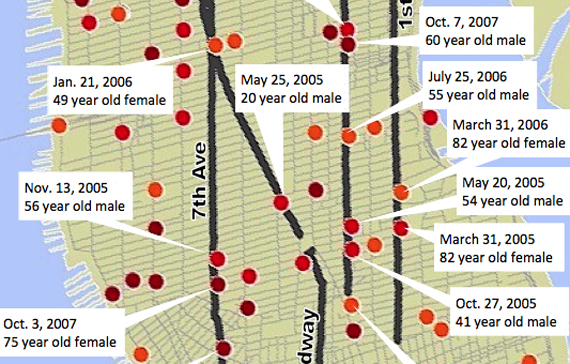TSTC Names the Most Dangerous Roads for Pedestrians

A new report from the Tri-State Transportation Campaign names five New York City streets among the region’s 10 most dangerous roads for pedestrians, based on the number of fatalities from 2005 to 2007. Making the list were:
- Third Avenue, Manhattan: 10 fatalities
- Broadway, Manhattan: 10 fatalities
- Grand Central Parkway, Queens: 9 fatalities
- Hylan Boulevard, Staten Island: 9 fatalities
- Atlantic Avenue, Brooklyn: 8 fatalities
TSTC found that two Long Island routes, Hempstead Turnpike in Nassau County and Sunrise Highway in Suffolk County, were the most deadly in terms of raw numbers, with 15 and 12 fatalities, respectively. Roads in New Jersey’s Atlantic, Burlington, Middlesex and Ocean Counties rounded out the list.
"The most dangerous roads are either extremely busy urban roads, such as 3rd Avenue in Manhattan, that handle many pedestrians and cars," said TSTC analyst Michelle Ernst, in the media release accompanying the report, "or, as with the case of Sunrise Highway in Suffolk County, they are major suburban roadways dotted with retail destinations but designed exclusively for fast-moving car traffic."
During the three years covered by the study, there were 147 pedestrian deaths in Brooklyn, 128 in Manhattan, 95 in Queens, 53 in the Bronx, and 26 in Staten Island. Narrowly missing the regional top 10 list were First and Seventh Avenues in Manhattan and Fourth Avenue in Brooklyn. Each saw seven fatalities.
TSTC acknowledged city DOT efforts to improve pedestrian conditions, but gave lower marks to New York State.
"It’s upsetting that roads on Long Island have more pedestrian fatalities than roads in dense urban areas, where people tend to walk much more," said Ryan Lynch, Senior Planner and Long Island Coordinator for the Campaign. "It’s clear that the New York State Department of Transportation isn’t providing safe walking routes for Long Islanders. This needs to change."
Borough and county fact sheets are available on the TSTC web site, and Mobilizing the Region has further analysis.